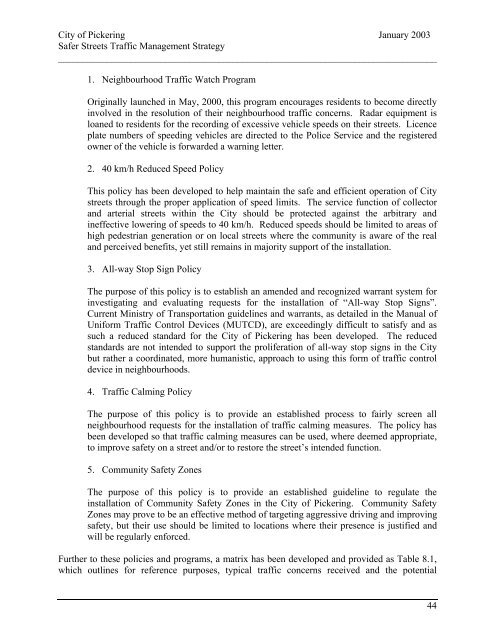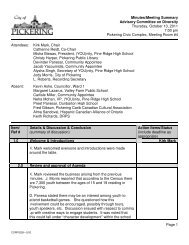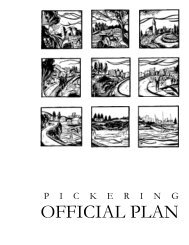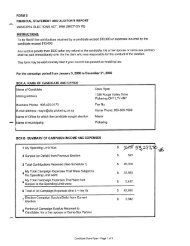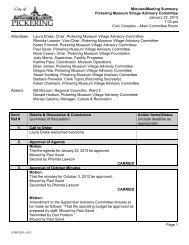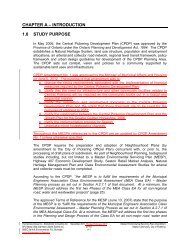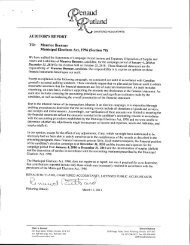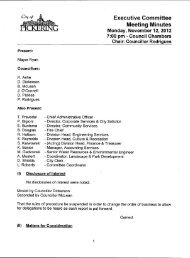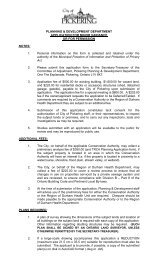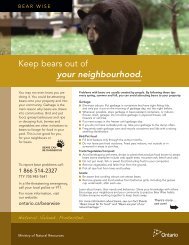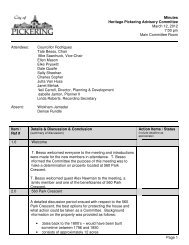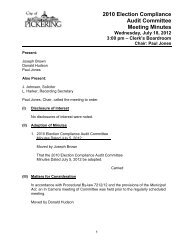foreword - City of Pickering
foreword - City of Pickering
foreword - City of Pickering
Create successful ePaper yourself
Turn your PDF publications into a flip-book with our unique Google optimized e-Paper software.
<strong>City</strong> <strong>of</strong> <strong>Pickering</strong> January 2003<br />
Safer Streets Traffic Management Strategy<br />
______________________________________________________________________________<br />
1. Neighbourhood Traffic Watch Program<br />
Originally launched in May, 2000, this program encourages residents to become directly<br />
involved in the resolution <strong>of</strong> their neighbourhood traffic concerns. Radar equipment is<br />
loaned to residents for the recording <strong>of</strong> excessive vehicle speeds on their streets. Licence<br />
plate numbers <strong>of</strong> speeding vehicles are directed to the Police Service and the registered<br />
owner <strong>of</strong> the vehicle is forwarded a warning letter.<br />
2. 40 km/h Reduced Speed Policy<br />
This policy has been developed to help maintain the safe and efficient operation <strong>of</strong> <strong>City</strong><br />
streets through the proper application <strong>of</strong> speed limits. The service function <strong>of</strong> collector<br />
and arterial streets within the <strong>City</strong> should be protected against the arbitrary and<br />
ineffective lowering <strong>of</strong> speeds to 40 km/h. Reduced speeds should be limited to areas <strong>of</strong><br />
high pedestrian generation or on local streets where the community is aware <strong>of</strong> the real<br />
and perceived benefits, yet still remains in majority support <strong>of</strong> the installation.<br />
3. All-way Stop Sign Policy<br />
The purpose <strong>of</strong> this policy is to establish an amended and recognized warrant system for<br />
investigating and evaluating requests for the installation <strong>of</strong> “All-way Stop Signs”.<br />
Current Ministry <strong>of</strong> Transportation guidelines and warrants, as detailed in the Manual <strong>of</strong><br />
Uniform Traffic Control Devices (MUTCD), are exceedingly difficult to satisfy and as<br />
such a reduced standard for the <strong>City</strong> <strong>of</strong> <strong>Pickering</strong> has been developed. The reduced<br />
standards are not intended to support the proliferation <strong>of</strong> all-way stop signs in the <strong>City</strong><br />
but rather a coordinated, more humanistic, approach to using this form <strong>of</strong> traffic control<br />
device in neighbourhoods.<br />
4. Traffic Calming Policy<br />
The purpose <strong>of</strong> this policy is to provide an established process to fairly screen all<br />
neighbourhood requests for the installation <strong>of</strong> traffic calming measures. The policy has<br />
been developed so that traffic calming measures can be used, where deemed appropriate,<br />
to improve safety on a street and/or to restore the street’s intended function.<br />
5. Community Safety Zones<br />
The purpose <strong>of</strong> this policy is to provide an established guideline to regulate the<br />
installation <strong>of</strong> Community Safety Zones in the <strong>City</strong> <strong>of</strong> <strong>Pickering</strong>. Community Safety<br />
Zones may prove to be an effective method <strong>of</strong> targeting aggressive driving and improving<br />
safety, but their use should be limited to locations where their presence is justified and<br />
will be regularly enforced.<br />
Further to these policies and programs, a matrix has been developed and provided as Table 8.1,<br />
which outlines for reference purposes, typical traffic concerns received and the potential<br />
44


